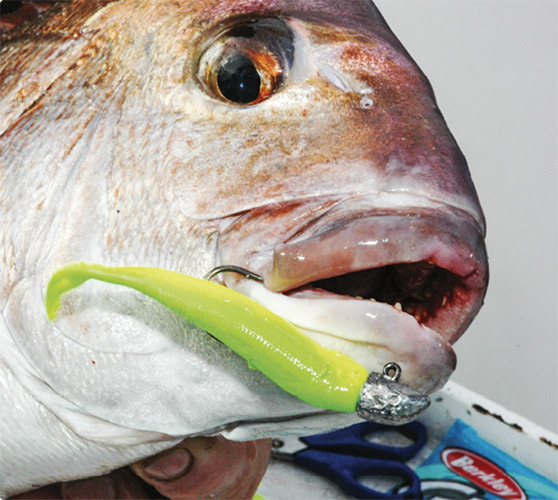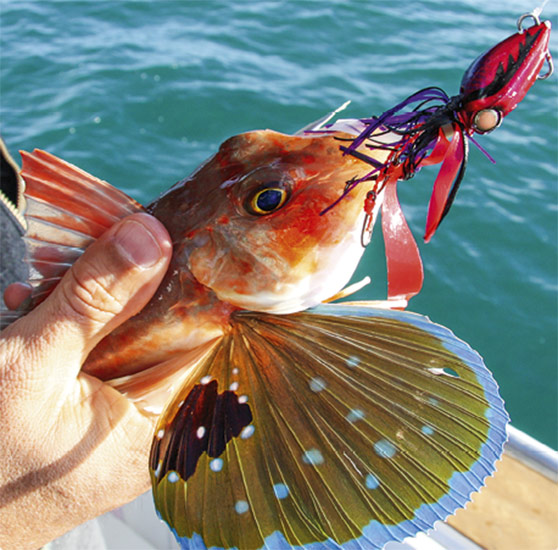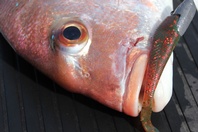How Important Is Fishing Lure Colour?
Previously, Ethan Neville looked into the science of fish memories, and found that yes, fish probably do remember your lure. This month, he looks at whether colour makes a difference to your catch rate…
We’ve all done it. During a slow morning on the water, a mate hooks into his second big fish, and before he can even get a couple of winds on, we’ve asked: “what colour lure are you using?” A few minutes later, we’ve swapped out our red inchiku for a pink one, or whatever colour best matches our mate’s. It simply has to be the colour – there’s no way another guy, (or any person for that matter) is actually just a better fisherman. Sometimes our mate’s ‘lucky’ run continues at our expense, but often a change of colour does the trick and we’re all hooking into fish.
Most fresh-water anglers will argue colour is essential, and every saltwater angler seems to have their own theories about which colours work best and when. But for every story about the importance of colour, there’s another about its unpredictability: one day pink works in the morning but won’t buy a bite the following day.

This lure colour matches no known baitfish, but is easy to see in poor light, enabling snapper to locate it easily.
The sensory world of fish
Vision forms a major part of most fish’s sensory world. Their eyes are surprisingly similar to ours: they use three pairs of muscles that swivel the eye on all axes, as well as retractor muscles and a suspensory ligament. With a spherical lens adapted to their conditions, fish, according to well-known ethologist Jonathan Balcomb, “can see as clearly underwater as we can in air”.
Most fish also see various colours. In regard to their physical make-up, fish can have up to four types of cone cells – one of which allows them to see ultraviolet light (hence ultra-violet reflecting lures). To put this into perspective, human eyes have three types of cone cells. The number of cones varies between species of fish, however, and may even change throughout their lifetime (some species only develop four cones in adulthood) or are only present in certain habitats (rainbow trout, for example, only have ultraviolet cones when living in freshwater). Not all fish have four cones, but it can be safely assumed that both the freshwater and predatory saltwater fish we hunt in New Zealand have some capacity to see in colour.
Even more compelling evidence for fish seeing in colour is the fact that fish express themselves through colour all the time. The colour of a fish at a given time can convey whether they are breeding, their gender, age, and even their mood. And these colours aren’t just a show for us air-breathing observers; the messages they convey are received loud and clear by both their fish friends and enemies.
Light and Water
Fish see colour. Confirmed. But what happens to colour underwater where there’s limited light? Don’t the reds vanish?
Great questions. Light is rapidly filtered out underwater, and with it colour. Due to the varying wave lengths, red vanishes at 10 metres deep, orange and yellow at around 30m, green at 50m and blue at 200m. These are very general figures as the extent to which water filters light is influenced by the clarity of the water, amount of wind, time of day and other factors. It is clear, however, that while fish can generally see well underwater, the colours will often be muted, if not completely lost at the right depth.

Light rapidly disappears underwater, and with it colour. This gurnard was caught in 50 metres of water, so it was most likely attracted to the lure's action rather than its colour.
With this information in hand, some fishermen will advise that lure colour isn’t important. Red can’t even be seen past 10m deep and other popular colours such as oranges, yellows and pinks have virtually vanished at the depths most people fish for snapper. However, things aren’t that simple. An object losing its colour does not make it invisible; it just makes it appear as black. As a marine biologist from Auckland University brought to my attention, the object may still be conspicuous against a background of scattered light. In fact objects are definitely conspicuous in water, even if their colour isn’t clear. Orange lures don’t suddenly stop catching fish at 50m deep and I have caught plenty of fish on red jigs below 10m of water. However, I believe that the deeper we drop lures the less important the colour is, and that different coloured lures may be more visible in different light conditions and at different depths.
But a more pertinent question remains unanswered: does colour actually influence the bite? Your red lure might be seen as black by a fish after 10m, but does this make the fish any less likely to attack it?
This question is a little tougher to answer.
Getting a fish to bite
Another science lesson: fish learn and remember colours easily. If you haven’t read my previous article in the August edition, please go do so now – or just take my word for it. Fish have an amazing capacity to remember, particularly when it comes to their food. They also have the capacity for belief.
Fish get fooled by optical illusions, just like us. This means they can be manipulated and deceived. They have a memory of what their food looks like but can be tricked into eating something that looks like it. This isn’t a sign of stupidity – this is a simple case of inference. If it looks and behaves like food (and in the case of bait, smells like food), it must be edible. If the colour of your lure matches the colour of the fish’s food, then there is a higher likelihood you will successfully deceive the fish into a hook up. This is the first, albeit well-known, piece of advice I can give. But if we take this logic further and speculate a little into unknown territory, we may be able to get some sense of which lure colours work better in certain conditions.

Lure colours that 'match the hatch' (represent the colour of the baitfish the predators are feeding on), are often successful.
A great number of fishermen – both saltwater and freshwater – swear by the fact that you should always match the lure to the light and water conditions. If it is overcast or the water is murky, use darker colours like oranges, reds and browns. On the middle of a sunny day or in crystal clear water, stick to the light colours like pink, blue and white. When we consider the research so far, this advice makes sense – particularly in shallower water.
If one of the key goals of a lure is to replicate the food source of the target species, a dark lure on a bright day would stick out but do little to deceive the fish. It may even be too blatant, so the fish may recognise it for what it is: a trap. Baitfish, with their typical silvery, reflective bellies use light to their advantage, and aren’t so obvious to predators looking up from below. As we’ve discovered, fish are smart enough that we do need to put some effort into manipulating their senses. Another marine biologist who I spoke to speculated that you want a jig to be visible, but not too visible (just as real prey are not). You want the fish to see the lure, but not see it for what it really is.
As you fish deeper, then colour may very well take second place to the other elements of a fish’s sensory world. Vibrations, sounds, and potentially even flashing lights will be more effective in capturing a fish’s attention.
Yes, colour probably does matter
What I have presented is a summary of some pretty complicated stuff. The movement of light through water is a tough subject, as is trying to understand the psychology of fish. Why they attack some lures and not others will always be somewhat of a mystery – but I guess that’s what makes fishing fun. What can be confirmed, however, is that science does indicate certain lure colours may be more effective than others in certain contexts. The natural food source, quality of light, and clarity of water all likely influence the colour of lure a fish will most likely attack on a given day.

Why fish attack some lures and not others will always be somewhat of a mystery - but that's what makes fishing fun.
Accordingly, my advice is to experiment. Your mate catching all the fish on a pink lure may not be a coincidence – give pink a go because it might make all the difference. When charter captains give their advice on what colours work when – listen. On opaque topics such as this, anecdotal evidence is often the best evidence.
|
|
This article is reproduced with permission of |
Recent Posts Visit Forum

Spammers Beware!
in Forum comments and feedback1 hour ago
Pcj
How does it keep getting through??Edit Grunta: All gone Paul - I've removed the links as they don't go anywhere but thanks for the heads-upThe reality...

Auckland Yakkers
in Yak Yak Yak1 hour ago
Hard Yakker
The birds were at Campbells today, yes all of the birds, I've never seen so many birds. It was a hot session, and surely a bad...
What I Bought Today
in T.A.S (Tackle Acquisition Syndrome)5 hours ago
Mc Tool
I used to manage a service dept for a nationwide department store , and once I got my head around stock control I was gobsmacked at ...
POPPING VANUATU
in Popper and Topwater Fishing6 hours ago
Fish Addict
Poppers vs stickbaits for dogtooth tuna. The Nomad website comments that stickbaits are preferred as poppers result in less hook ups at strike. I have also...

Anyone get out today??
in Landbased & Surfcasting14 hours ago
smudge
What was the bait you were using?...
Popular Articles

Softbait Fishing - Part 1 - gear selection
John Eichlesheim writes an article about selecting the right equipment for softbait fishing... Read More >

Softbait fishing Pt 2 - tips and tricks
Techniques, tips and tricks of softbait fishing – getting the most from your soft baits.... Read More >

Surfcasting - setting yourself up
Gary Kemsley helps sort out the necessary gear for intending surf fishers.... Read More >

Squid - How to catch them
Squid fishing is a rapidly growing aspect of fishing - Paul Senior shares some hints and tips to get started.... Read More >
Fishing Reports Visit Reports
Canterbury Fishing Report - 04/04/24
Fish galore! Coming off the back of Easter Weekend and with some very nice weather... Read More >
Raglan Fishing Report - 04/04/24
Excellent snapper action There is some excellent autumn snapper fishing straight out and up the... Read More >
Bream Bay Fishing Report - 04/04/24
Whangarei Harbour fishing well Like the weather, the fishing has been patchy throughout Bream Bay... Read More >
Hauraki Gulf Fishing Report - 04/04/24
Party time! Inshore fishing and offshore fishing are on now. It’s that perfect time of... Read More >


Comments